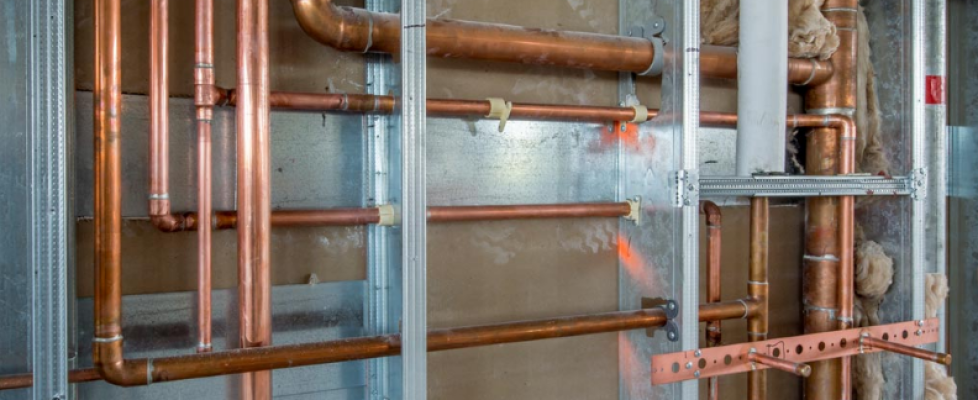The Copper Re-Piping Guide
Copper repiping is an essential project for many homeowners, especially those living in older homes. Over time, plumbing systems can degrade, leading to leaks, reduced water pressure, and other issues that can affect your home’s overall functionality. Copper repiping offers a long-lasting solution to these problems, making it a preferred choice for many. But why exactly would you need copper repiping, and what does the process entail? Let’s dive into the details.
Why Consider Copper Repiping?
Two primary reasons drive the decision for copper repiping: leaking pipes and low water pressure. Homes built more than 25 years ago commonly have galvanized or iron pipes, which are prone to rust and corrosion. These pipes were typically coated with zinc, but over time, the zinc wears off, leading to the deterioration of the pipes and, eventually, rust. This corrosion restricts water flow and can result in frequent leaks.
Replacing these outdated pipes with copper piping offers numerous benefits:
- Durability: Copper pipes are resistant to rust and corrosion, providing a long-lasting solution.
- Improved Water Pressure: Copper repiping can restore proper water flow, resolving low-pressure issues.
- Safe Drinking Water: Copper pipes don’t corrode as easily as galvanized ones, reducing the chance of contaminants entering your water supply.
Steps to Consider When repiping with Copper
Copper repiping is not a small project. It involves replacing large portions, if not all, of your home’s plumbing system. If you’re considering taking on this project yourself, it’s crucial to be prepared. Below are key steps and considerations for a successful repiping job:
- Understand the Existing Pipe Layout Before starting the repiping process, you’ll need to be familiar with your home’s current pipe layout. This knowledge is essential because the new copper pipes should mirror the old piping system as closely as possible. This will minimize disruptions to your home’s structure and ensure that everything works as it should.
- Running Copper Pipes One way to make the copper repiping process easier is by running the new pipes alongside the old ones. This allows you to install the new pipes while keeping the existing system in place until you’re ready to make the switch. It’s a practical method that can help avoid prolonged water shut-offs.
- Have the Right Tools and Fittings A successful copper repiping job requires the right tools and materials. You’ll need various fittings, including adapters, elbows, and tees, to connect the pipes and navigate your home’s plumbing layout. Be sure to have an ample supply of fittings to avoid delays.
- Clean the Pipes and Fittings Before soldering, it’s essential to clean the copper pipes and fittings thoroughly. This is where flux paste comes into play. Flux is an acidic paste that cleans the copper surfaces and makes them easier to solder. Proper cleaning ensures a strong, leak-free connection between the pipes and fittings.
- Soldering the Pipes Soldering is one of the most critical steps in copper repiping. It involves heating the copper pipes and fittings and applying solder to create a secure connection. If you’re not familiar with soldering, it’s worth seeking advice from a professional or doing extensive research beforehand. Poor soldering can lead to leaks and other problems down the road.
- Double-Check Your Work After installing the new copper pipes, it’s vital to double-check your work. Make sure that cold water lines are connected to cold water pipes and hot water lines are connected to hot water pipes. Even a small mistake can cause significant problems once the system is in use.
Leave It to the Professionals
While DIY projects can be rewarding, copper repiping is an extensive and complex task that requires a high level of skill and knowledge. If you’re unsure about any part of the process, it’s best to leave the job to a professional plumber. Licensed professionals have the experience and tools needed to complete the project efficiently and safely.
A professional plumber will assess your home’s plumbing system, provide an accurate estimate, and ensure that the repiping is done correctly. In addition to offering peace of mind, hiring a professional can save you time and money in the long run, as you’ll avoid potential mistakes and rework.
Finding the Right Plumbing Company
When considering copper repiping, it’s essential to choose a reputable plumbing company. Here are some tips for finding the right professionals for the job:
- Get Multiple Quotes: Contact several plumbing companies to compare prices. While cost is a factor, don’t choose a company solely based on the lowest quote. Instead, consider the company’s reputation, experience, and the quality of materials they use.
- Check Reviews and References: Look for online reviews or ask for references from previous customers. This can give you an idea of the company’s reliability, quality of work, and customer service.
- Ask About Warranties: A reputable company should offer a warranty on their work. This guarantees that if anything goes wrong after the installation, the company will address the issue at no additional cost to you.
Conclusion
Copper repiping is a significant investment, but it’s one that can offer substantial long-term benefits. By replacing old, corroded pipes with durable copper piping, you can improve your home’s water pressure, reduce the risk of leaks, and ensure the safety of your drinking water.
Whether you choose to tackle the project yourself or hire a professional plumber, it’s essential to approach copper repiping with careful planning and attention to detail. If you’re ever unsure about the process, don’t hesitate to reach out to experts who can guide you through the process and ensure the job is done right.
For homeowners looking for a long-lasting, reliable solution to plumbing issues, copper repiping is an excellent choice. With the help of experienced professionals, you can enjoy the benefits of a modern, efficient plumbing system that will serve your home for years to come.


